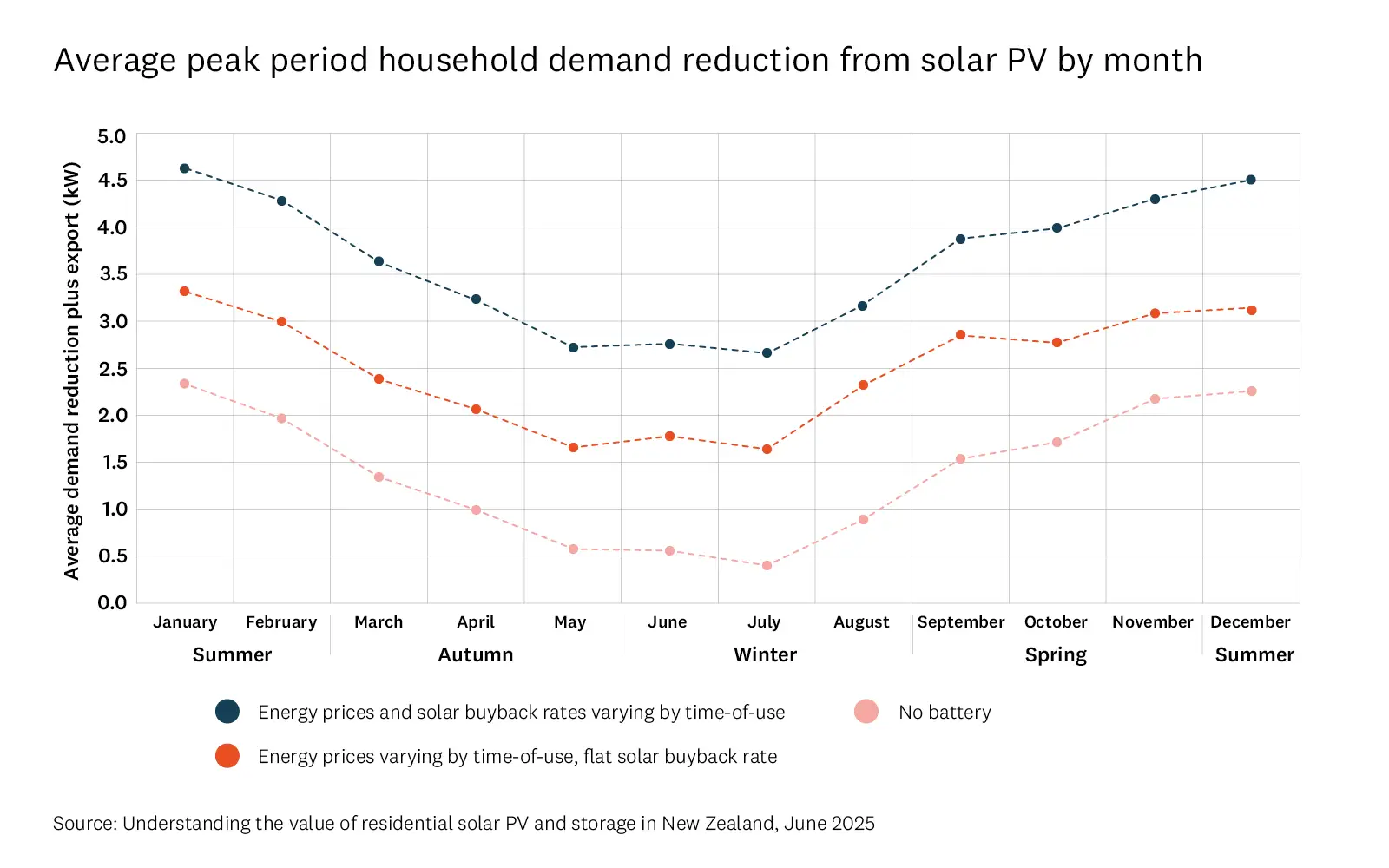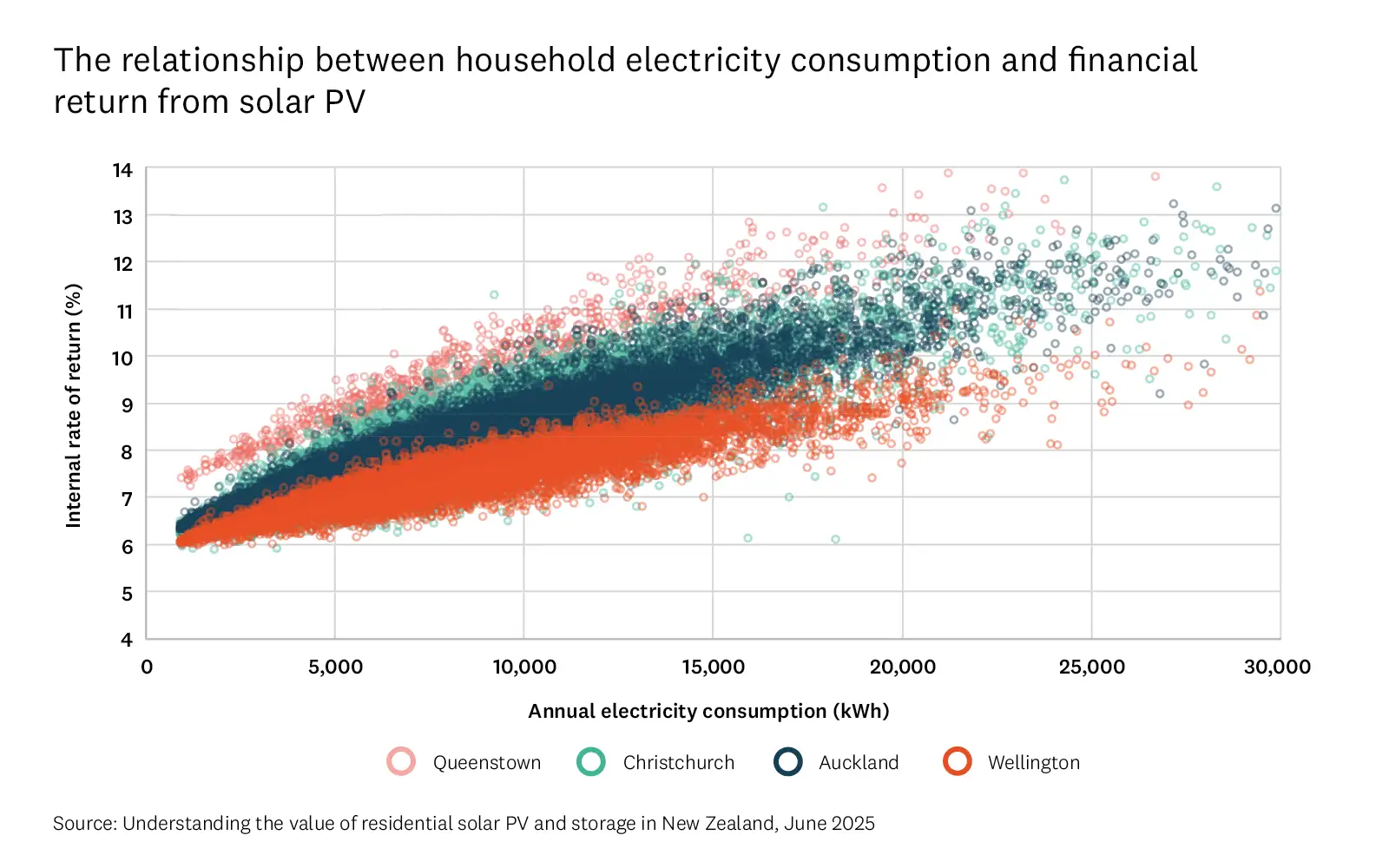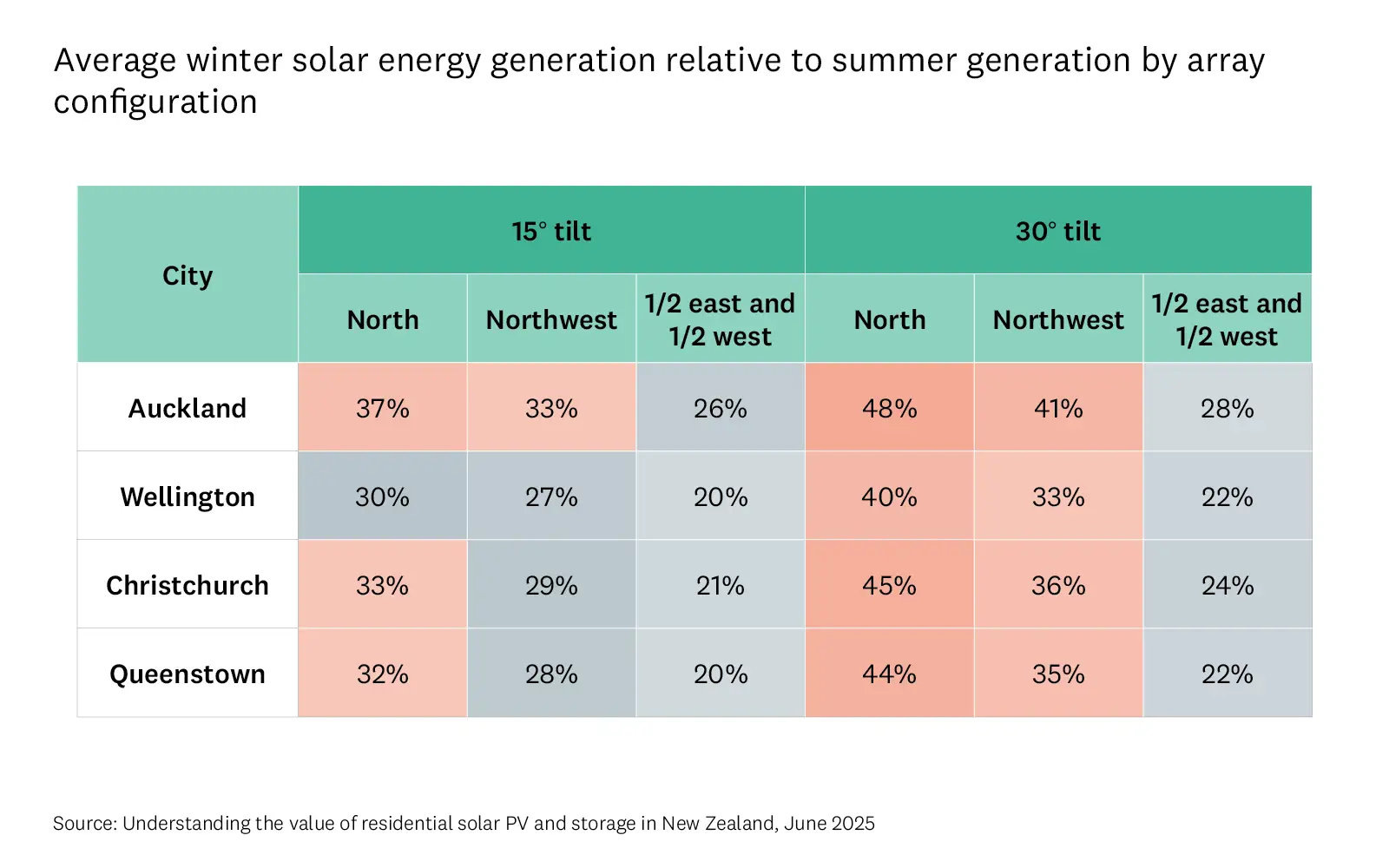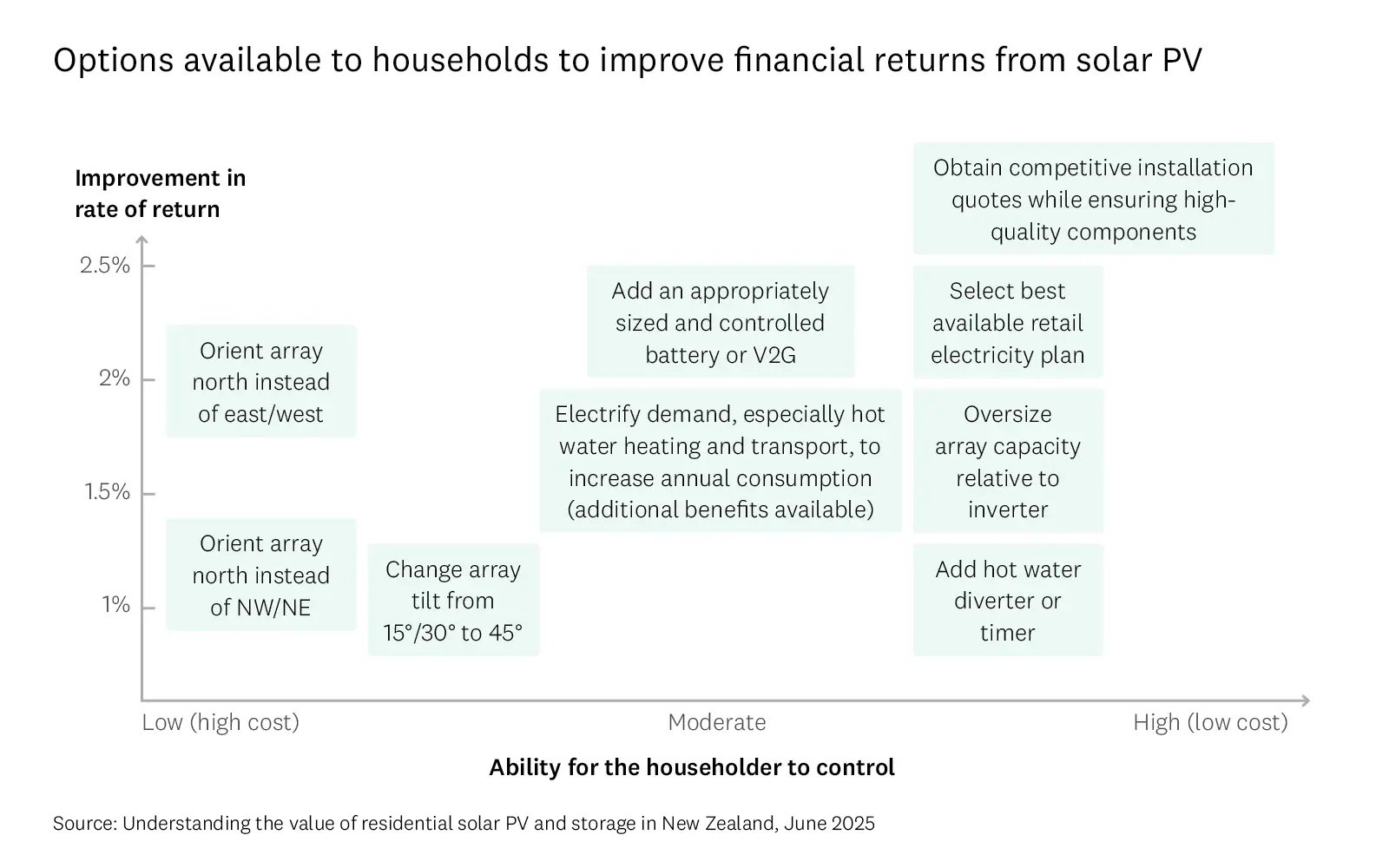Overview
Residential rooftop solar PV provides a means for consumers to lower their electricity costs, particularly if they choose to move more of their household energy consumption to electricity.
This is the first study in New Zealand to use detailed and high-quality data for both solar supply and residential demand. It shows solar PV is likely to be financially viable for a significant proportion of New Zealand households, particularly for those who consume a lot of energy.
We investigated the internal rate of return (IRR) of solar PV to a homeowner and how these returns vary with local solar resource and electricity prices, alongside changing technology costs, storage options, solar installation configurations, and alternative distribution, transmission, and retail pricing structures.
EECA’s objective was to establish “Where and under what conditions does investing in solar PV make sense?”, to support homeowners with making informed choices about value-for-money when considering installing solar PV.
This research investigates the value of solar in more detail, including across a broader range of conditions, than has been possible in the past. We used a large database of anonymised real-world electricity demand data across 4 main centres in both the North and South Islands of New Zealand.
Key findings
Households that consume more electricity, particularly in the morning and daytime, see the best financial returns from solar PV.
The more appliances that are powered by electricity, the more self-generated solar energy can be used directly, reducing reliance on grid electricity.
While waste should always be avoided, more household consumption means a greater opportunity to replace grid electricity with self-generated solar energy. Homes that use more power during the morning (7-11am) and daytime benefit the most since solar generates electricity during these hours.
Households that switch from gas to electric heating, cooking, and water heating will benefit more from solar PV. Charging an electric vehicle (EV) at home during the day can significantly increase solar self-consumption.

Location matters
Financial returns vary across cities, depending on electricity prices in each area and a solar resource which depends on the local climate. Results show that, in contrast to common assumptions, southern locations in New Zealand are not necessarily worse for solar PV.
This research modelled solar PV system operation using real-world 30-minute demand data from almost 50,000 homes across 4 New Zealand cities for a full year:
Queenstown
- Best solar resource overall (e.g. most sunlight hours per year).
- Higher potential returns due to strong solar generation and moderate electricity prices.
- IRR is around 7-14% per year with a north-facing 5 kW solar array at 30° tilt and no storage.
Auckland
- Second-best solar resource after Queenstown.
- Higher electricity prices, making solar PV attractive.
- IRR is around 6-12% per year with a north-facing 5 kW solar array at 30° tilt and no storage.
Christchurch
- Similar solar conditions to Auckland, though slightly lower overall due to higher latitude.
- Retail electricity prices are lower than in Auckland and Queenstown, which can slightly reduce financial benefit.
- IRR is around 6-11% per year with a north-facing 5 kW solar array at 30° tilt and no storage.
Wellington
- Lowest solar resource of locations studied due to a higher number of cloudy days per year.
- Moderate electricity prices help balance out the lower solar potential.
- IRR is lower than other centres but can still reach 10% for some households.
For all of the above, the appropriate storage solutions can boost IRR by 1-2%. However, this additional benefit is sensitive to pricing structures, storage technology costs, and the households’ particular usage profile.
Time-of-use pricing can further improve returns if a battery is included in the installation.

North-facing panels with a tilt of 30° or more are best. East- and west-facing panels don’t meaningfully improve generation during peak periods in New Zealand.
Most solar PV panels in New Zealand are installed facing as close to north as possible to maximise total electricity generation. However, some homeowners choose to install east- and west-facing arrays to try and match their solar generation and energy use more closely.
Here’s how they compare:
North-facing panels (typical setup)
- Generate the most electricity over the course of the day.
- Best for households with steady daytime energy use or those exporting excess energy to the grid.
- Produce more power than can be used or exported in the middle of the day when demand is low.
East-west-facing panels
- East-facing panels generate more in the morning.
- West-facing panels generate more in the afternoon and early evening.
- This can align more closely with higher morning and evening demand in most households.
- Overall electricity generation is significantly lower compared to north-facing panels.
- Arranging panels in this way has negligible benefit in terms of peak demand reduction because there is still little to no generation during winter evenings, when demand is usually at its highest.
East- and west-facing solar arrays do not significantly improve the ability of solar PV to reduce peak electricity demand in winter. Even in northern regions, solar generation remains too low in the early mornings and late evenings to make a meaningful difference during peak demand periods.

Batteries are the only real solution that will allow peak morning and evening demand to be met with local supply, but they need to fall further in price.
Batteries can increase the financial benefits from solar PV but remain too expensive for many households in New Zealand.
Instead of batteries, hot water diverters and timers can improve returns with lower upfront costs by making use of existing hot water cylinders to store solar energy.
EV batteries could also be used for storage, with Vehicle-to-Grid (V2G) technology, but key challenges remain, such as V2G charger costs and limitations imposed by battery warranties from some vehicle manufacturers.
Households have a variety of options available to improve the value of solar PV to them.
For example, one of the easiest things to do with a large impact on financial return is to shop around solar installers to find the best deal, then checking offered components online to make sure they are reliable and sourced from reputable manufacturers.
A close second is ensuring you are on the best available electricity retail plan considering the solar system you plan to install.
Storage is an option which can boost overall returns from solar PV, but the right choice of capacity and technology will depend on component costs, your location, electricity plan, and consumption profile, and even how much control you have over energy-consuming devices in your home.

Read next
-
Electrifying Aotearoa: The consumer perspective
New consumer research explores the status of household electrification among owner-occupiers in New Zealand.
- Electricity
- Products & appliances
- Market research
-
Commercial-scale solar in New Zealand
Information for businesses considering investing in solar energy.
- Renewable energy
- Solar energy
- Decarbonisation
-
Residential solar in New Zealand: The customer journey
This market research looks at the customer’s perspective of investigating, researching, financing and installing solar in New Zealand.
- Solar energy
- Market research

